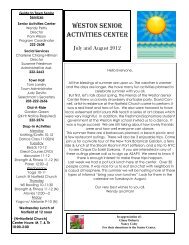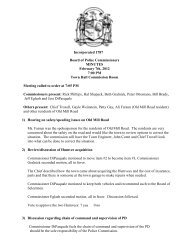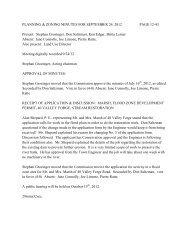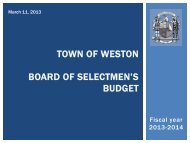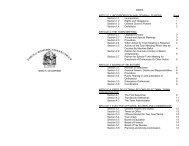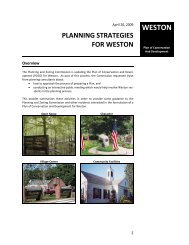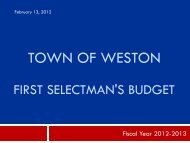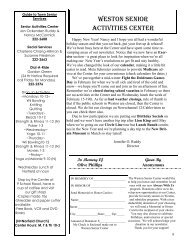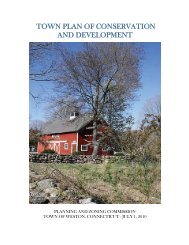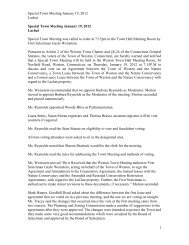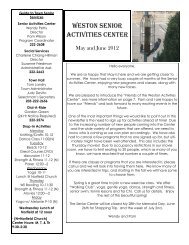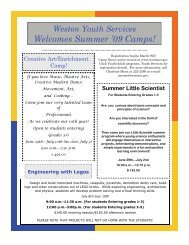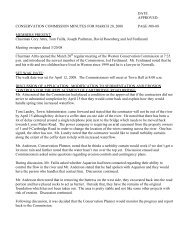Regional Plan of Conservation and Development, 2006-2015
Regional Plan of Conservation and Development, 2006-2015
Regional Plan of Conservation and Development, 2006-2015
Create successful ePaper yourself
Turn your PDF publications into a flip-book with our unique Google optimized e-Paper software.
Chapter 5 – Transportation,Infrastructure <strong>and</strong> Critical Facilities<strong>Regional</strong> <strong>Plan</strong> <strong>of</strong> <strong>Conservation</strong> <strong>and</strong> <strong>Development</strong>, <strong>2006</strong>-<strong>2015</strong>Infrastructure is the physical backbone <strong>of</strong> anycommunity. Significant investments are made eachyear to maintain <strong>and</strong> grow existing infrastructure.These investments – which are funded through varioustaxes as well as regulatory <strong>and</strong> user fees – are madeby state <strong>and</strong> federal agencies, municipal governments<strong>and</strong> service providers. Such investments also aremade by individuals <strong>and</strong> organizations living <strong>and</strong> doingbusiness in the Region.Over the next 10 years, increasing investment ininfrastructure will be needed, not only to keep pacewith the Region’s growth but to maintain, repair <strong>and</strong>replace aging infrastructure. The financial pressureassociated with such investment may push providers<strong>and</strong> beneficiaries <strong>of</strong> the Region’s infrastructure <strong>and</strong> itsoutputs to seek new resources <strong>and</strong> achieveeconomies <strong>of</strong> scale. Increased regionalization <strong>of</strong>delivery systems <strong>and</strong> service sharing may be amongthe solutions.Assembling the resources needed to grow <strong>and</strong>maintain infrastructure is only one <strong>of</strong> the challengesfacing the Region. Achieving consensus on the need<strong>and</strong> location <strong>of</strong> such infrastructure in a legalenvironment that, for many infrastructure projects,gives local governments little or no role in the decisionmakingprocess further complicates the alreadycomplex intersection <strong>of</strong> l<strong>and</strong> use, infrastructure <strong>and</strong>services, finance <strong>and</strong>, <strong>of</strong> course, politics.TransportationThe Region’s transportation infrastructure played asignificant role in its development as a hub <strong>of</strong>economic, residential <strong>and</strong> cultural activities. TheRegion is served by several major transportationfacilities including Interstate 95, the Merritt Parkway,U.S. Routes 1 <strong>and</strong> 7, <strong>and</strong> the New Haven, New Canaan<strong>and</strong> Danbury rail lines. The Region also is served by astrong network <strong>of</strong> local, regional <strong>and</strong> inter-city bustransit services, as well as various paratransit services.These transportation connections have made theRegion easily accessible to <strong>and</strong> from a number <strong>of</strong>major cities <strong>and</strong> metropolitan areas, including NewYork, Boston, Philadelphia <strong>and</strong> Washington. TheRegion’s accessibility has, however, also contributedto a rise in traffic congestion <strong>and</strong> associated delays.Several solutions to the Region’s traffic congestionhave been identified. First, opportunities exist toexp<strong>and</strong> transit services <strong>and</strong> opportunities for bikingInterstate 95 <strong>and</strong> the New Haven Linerailroad tracks, Stamford<strong>and</strong> walking to provide persons traveling to, from <strong>and</strong>within the Region with safe, convenient <strong>and</strong> affordablealternatives to the automobile. Second, dem<strong>and</strong>management strategies – including ridesharingprograms <strong>and</strong> various incentives to induce the use <strong>of</strong>transit, telecommuting <strong>and</strong> alternate work schedules –have the potential to encourage travelers to leave theircars at home. Opportunities also exist to change theway freight is moved to <strong>and</strong> through the Region, suchas increased use <strong>of</strong> rail <strong>and</strong> barges.Although seemingly unrelated to transportationinfrastructure, perhaps the greatest power to mitigatetraffic congestion rests with the Region’s municipall<strong>and</strong>-use boards. In any community, l<strong>and</strong>-use policies<strong>and</strong> practices play a critical role in establishingpopulation densities, the balance between residential<strong>and</strong> commercial l<strong>and</strong> uses <strong>and</strong> the location <strong>of</strong> certaintransportation <strong>and</strong> public facilities. Research hasshown these factors impact the number <strong>of</strong> vehicletrips, vehicle miles traveled, <strong>and</strong> availability <strong>and</strong> choice<strong>of</strong> travel options. Hence, smart growth decisions canshape travel trends <strong>and</strong> options available within amunicipality or the Region. L<strong>and</strong>-use strategies <strong>and</strong>techniques that support transportation options <strong>and</strong>their benefits are discussed in more detail in Chapter 4.In 2005, two major pieces <strong>of</strong> legislation werepassed that would significantly increase transportationinvestment in the Region <strong>and</strong> the rest <strong>of</strong> the state. In2005, Public Act 05-4 (June Special Session) wasenacted to provide $1.3-billion to repair <strong>and</strong> replaceConnecticut’s aging transportation infrastructure <strong>and</strong>equipment. Among the specific investments includedin the act was the complete replacement <strong>of</strong> the NewHaven Line railcar fleet, the construction <strong>of</strong> a new fleet25



